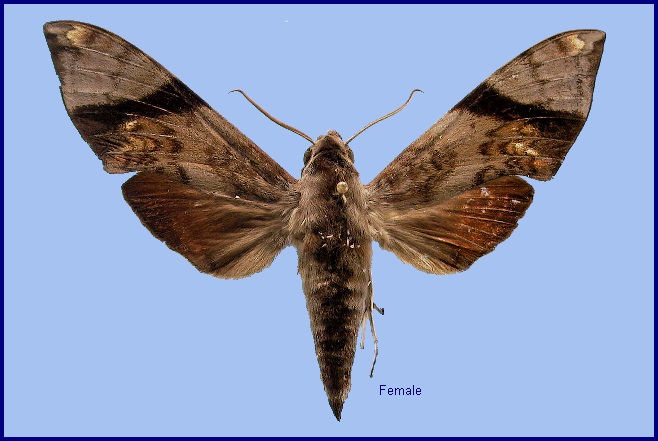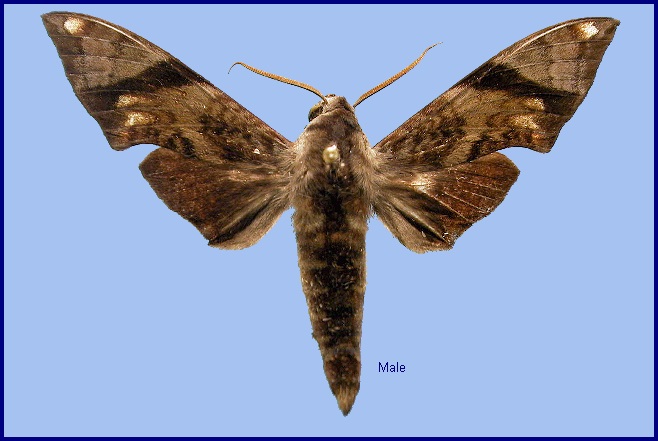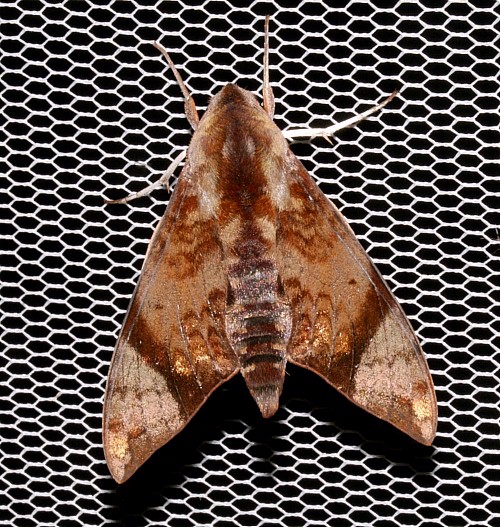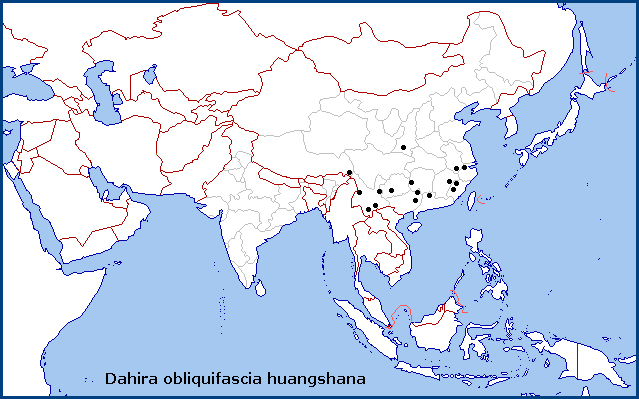

Acosmeryx huangshana Meng, 1982, Entomotaxonomia 4: 55. Type locality: [China] Anhui, Mt Huangshan [Huang Shan].
Synonym. Ampelophaga fujiana Zhu & Wang, 1997.
Note. According to Haxaire, Melichar & Manjunatha (2021), this species has an incredible level of variation in the male genital armature, in particular in the shape of the apical processes of the phallus and harpe. However, unlike in Dahira rubiginosa, the variation in Dahira obliquifascia 'seems' to follow a biogeographical logic, although it must be used with extreme care, and in its entirety. In addition, DNA barcode analysis shows clear separation of the populations from Taiwan, southeast China, northeast India and mainland South East Asia. As in Dahira rubiginosa, Haxaire, Melichar & Manjunatha (2021) accept that this separation makes biogeographical sense and treat these four groups as subspecies. Names for two already existed in the synonymy, and these were revalidated. They describe a third, South East Asian subspecies, as new, namely Dahira obliquifascia siamensis Melichar & Haxaire, 2021. In this taxon, all specimens from South East Asia that Haxaire, Melichar & Manjunatha (2021) examined have the apical plate of the end of the phallus more flattened and more strongly serrated, compared with the nominotypical Indian population. Also, there is, on average, a 2% divergence in their DNA barcodes from Dahira obliquifascia obliquifascia and Dahira obliquifascia huangshana. The adult moths are statistically larger and more slender than those of Dahira obliquifascia huangshana. Their coloration is more shimmering, but without reaching the level of contrast of the moths of northern India.
Note. Moths from southeastern China are quite variable in colour and size, but consistent in their DNA barcodes. They are closer to the Taiwanese population than to the nominotypical subspecies from India (Haxaire, Melichar & Manjunatha, 2021).
Note. Qi, Zhang, Wang & Huang (2022) sequenced and analyzed the complete mitogenome of Dahira obliquifascia huangshana from Menghai County, Xishuangbanna, Yunnan, in order to compare mitogenomic structures between 26 species of Sphingidae, and construct phylogenetic relationships. The complete mitogenome sequence of Dahira obliquifascia huangshana was found to be circular, 15,939 bp in size and encoded 13 protein-coding genes (PCGs), 2 ribosomal RNA genes (rRNA), 22 transfer RNA genes (tRNA) and a control region (CR). Nucleotide composition was highly biased toward A + T nucleotides (80.3%). All 13 protein-coding genes (PCGs) initiated with the standard start codon of ATN and terminated with the typical stop codon TAA/TAG. Phylogenetic analyses performed using 13 protein coding genes (PCGs) showed that Dahira obliquifascia huangshana was closest to Theretra japonica (Boisduval, 1869).
Wingspan: 78mm. Forewing upperside purplish-grey, tinged in parts with reddish-brown; subbasal diffuse reddish-brown marks in cell and on 2A+3A; three rather indistinct, diffuse, waved, antemedian brown lines; a small discoidal dot; a broad blackish-brown band from middle of costa to outer margin at M3, expanding into a large triangular patch on outer margin extending almost to tornus; a postmedian line slightly dentate from costa to the blackish-brown band, then oblique and more strongly dentate, with some fulvous-yellow on its outer side, a waved line before it from Cu2 to inner margin and two waved lines beyond it from the band to the inner margin; a double brownish, slightly waved submarginal line from costa to M2; a wedge-shaped brown mark on outer margin below apex; cilia blackish-brown. Hindwing dark brown tinged with red, the inner area greyish; cilia rufous, whitish at tips. Underside: breast orange-red; forewing fiery-red, with the outer margin grey, some dark brown suffusion in and below cell; six indistinct waved lines in postmedian area; a pale yellow subapical lunule and two wedge-shaped postmedian marks below Cu1 and Cu2; hindwing fiery-red, the inner area greyish, marginal area brownish; three indistinct, minutely waved, red postmedian lines. Head and thorax grey slightly mixed with reddish-brown, vertex of head and dorsum of thorax reddish-brown; abdomen grey, with broad dorsal, diffuse, reddish-brown bands.

Generally between 600m and 1800m altitude.
China: 24.ii-19.iii (Simao/Pu'er, Yunnan); iv (Guizhou); 8-17.iv (Yunnan); 5.v (Simao/Pu'er, Yunnan); 6.v.2017 (Fujian); 31.v (Guangdong); 13.vi.2015 (Guangxi); 17.vi.2017 (Zhejiang).
OVUM: Unknown.
LARVA: Unknown.
PUPA: Unknown.
Larval hostplants. Unknown.
Unknown.
China: Shaanxi (Foping County, Qinling, 1800m); Anhui (Huang Shan); Zhejiang (Lin'an, West Tianmushan, 840 m; Lishui; Hangzhou Nantianmu Forest Park; Datianping); Yunnan (Simao/Pu'er; Pingdi; Xuanwei; Lushui, 900m; Menghai County, Xishuangbanna; Yuxi; Mopanshan National Forest Park; Silaluo); Xizang/Tibet (east); Guizhou; Hunan (Jiucai Ling, 1300m); Jiangxi (Wuyi Shan, 50km SE Yingtan, 1600m; Shangrao; Baisha Guanqiao Bridge, De Xing Shi); Fujian (Huangkeng; Sanming, Youxi County, 710 m; Wuyi Shan, 1400m); Guangdong (Nanling National Forest Park, 1100m); Guangxi (Maoer Shan, 1800m; Jinxiu County, Dayaoshan, 880-1700 m).
Southeastern China.
[Dahira obliquifascia obliquifascia (Hampson, 1910) occurs in Nepal and northeast India (Meghalaya, Arunachal Pradesh and Mizoram), at some altitude (1200-2500m), where the moth can be very common. Dahira obliquifascia siamensis Melichar & Haxaire, 2021, occurs in Laos, Thailand, Vietnam and peninsular Malaysia, and, possibly, just into Yunnan, China (Menglian County, Kabieke Shan). Dahira obliquifascia baibarana (Matsumura, 1927) is confined to Taiwan (Haxaire, Melichar & Manjunatha, 2021).]

 Return to Sphingidae of the Eastern Palaearctic species list
Return to Sphingidae of the Eastern Palaearctic species list